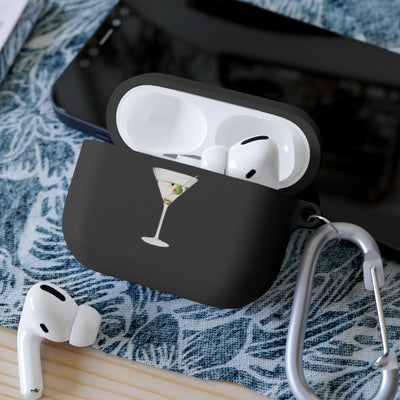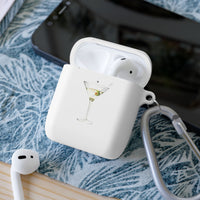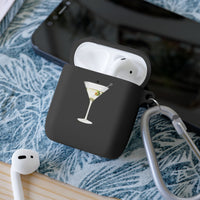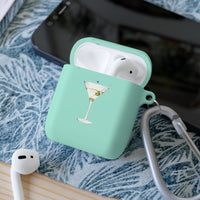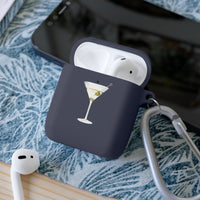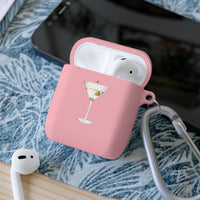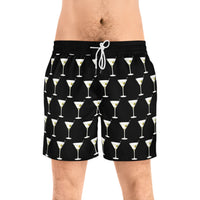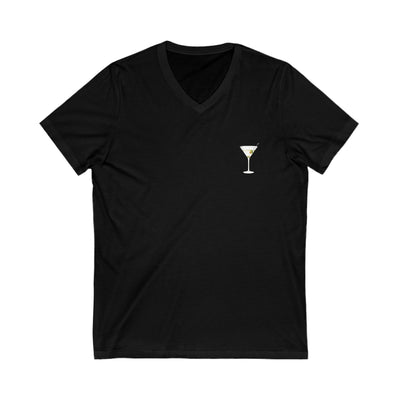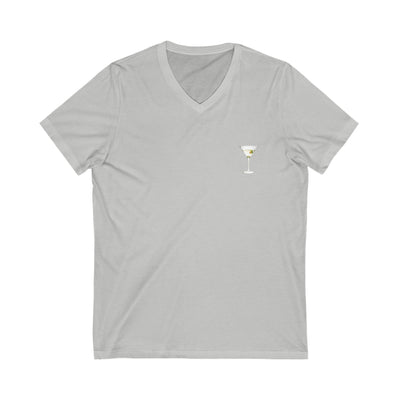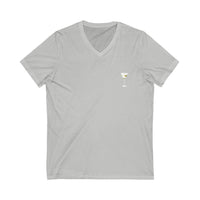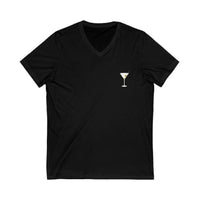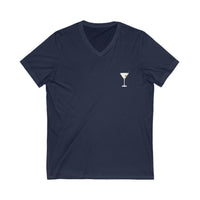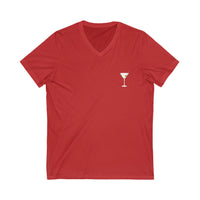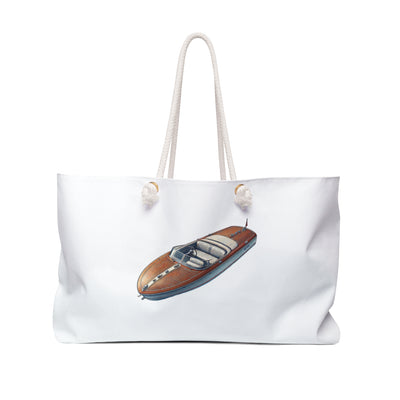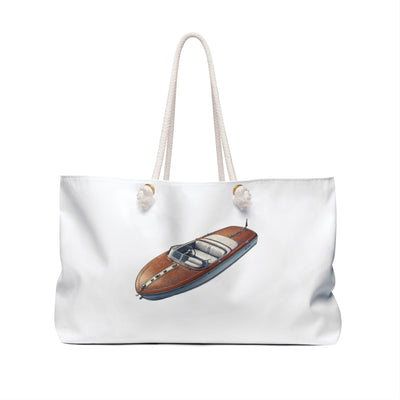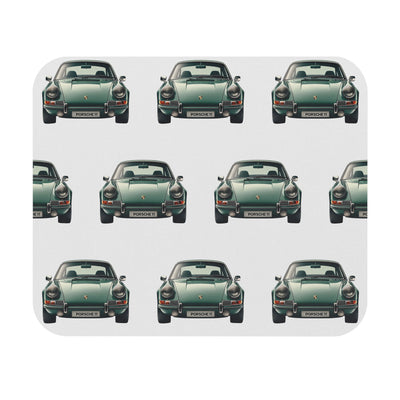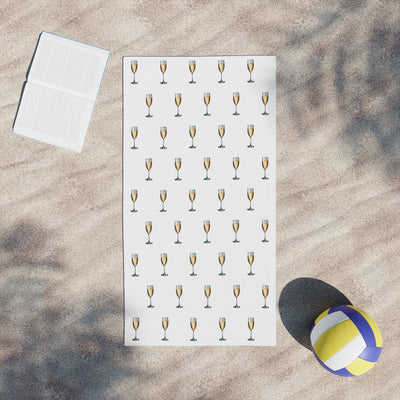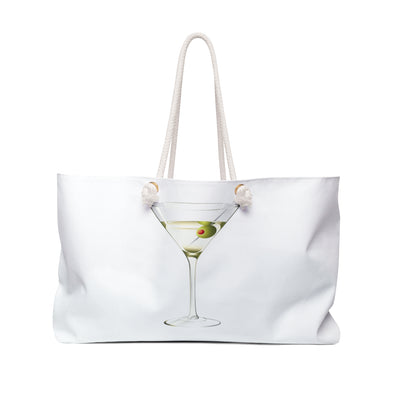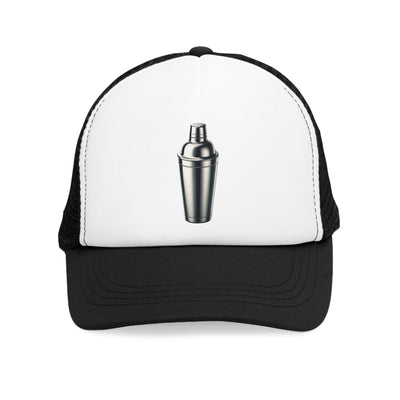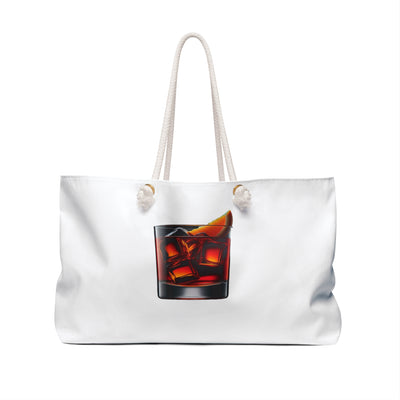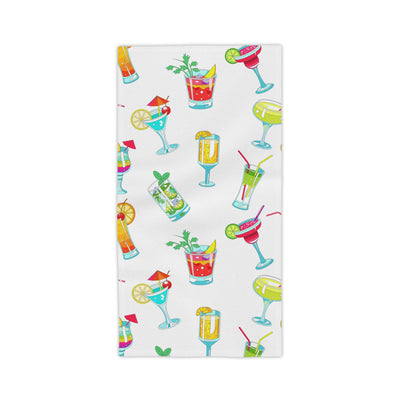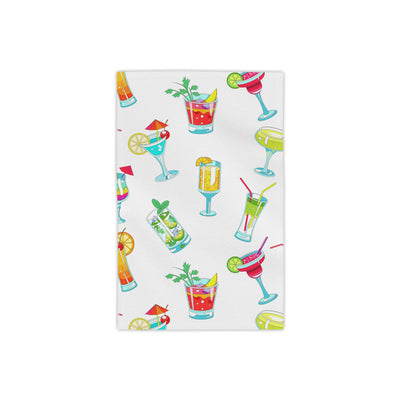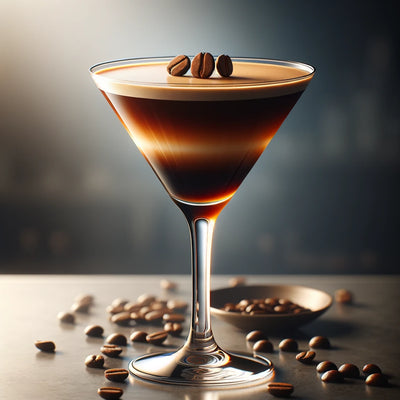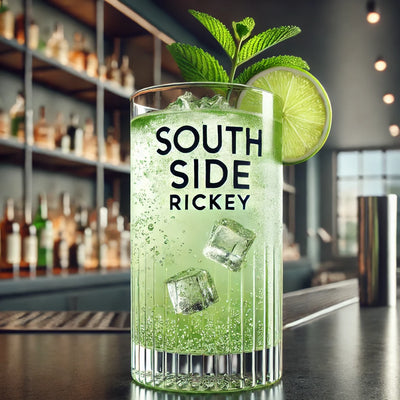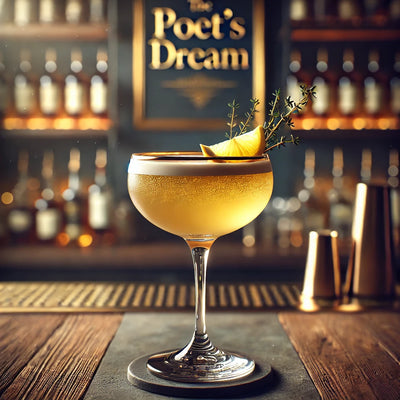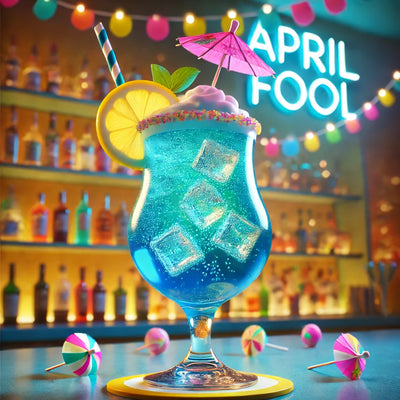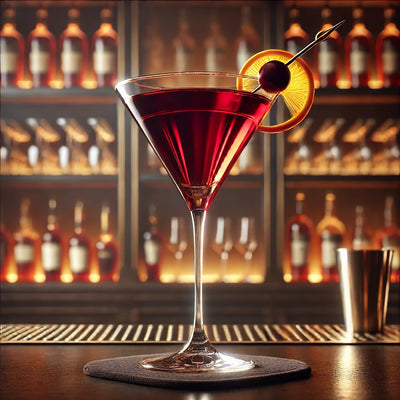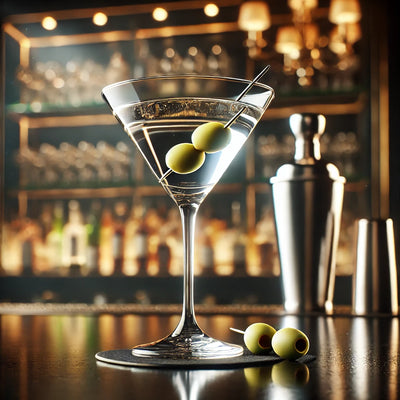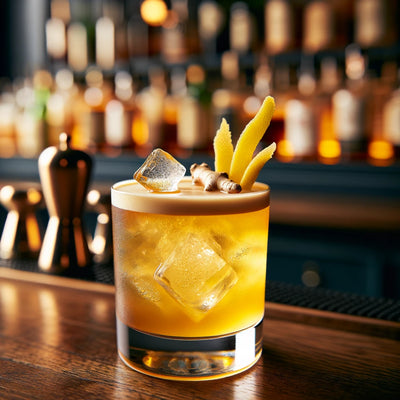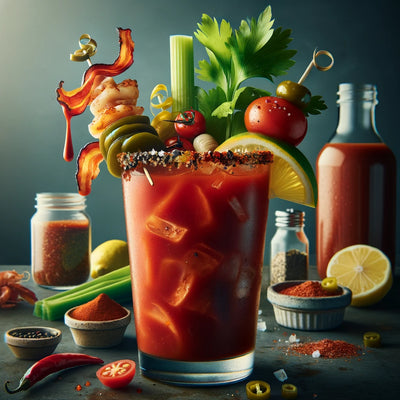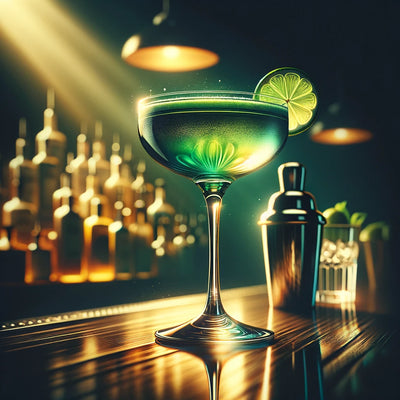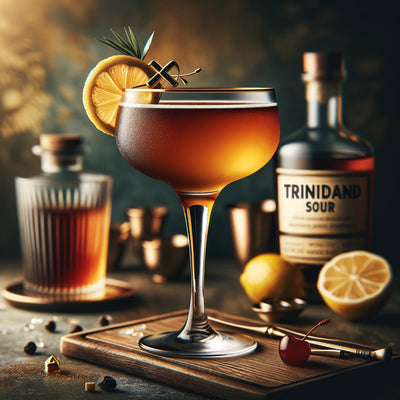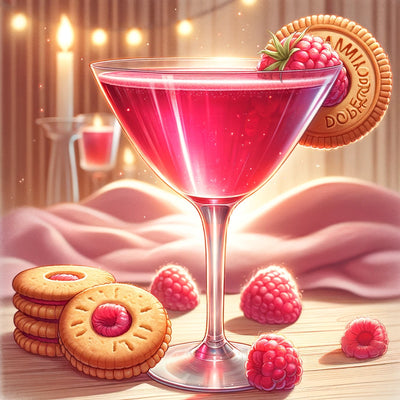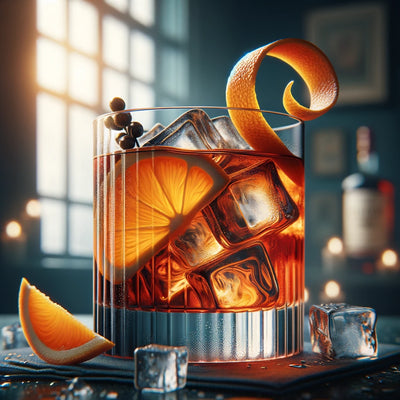Have a question?

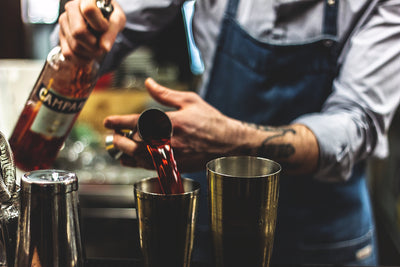
Cocktail Shaker: What is a Cocktail Shaker and how is it used?
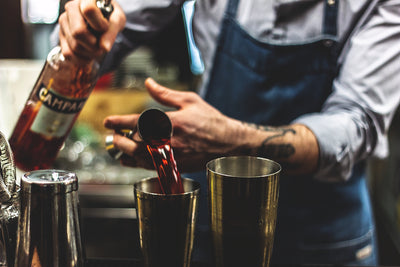
Parisian shaker: What is a Parisian shaker and how is it used?
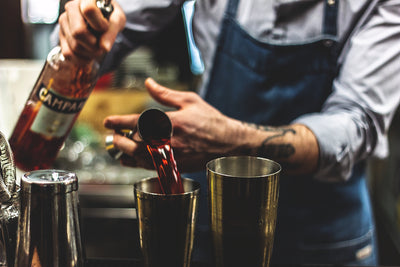
Muddler: What is a Muddler and how is it used?

Mixing Glass: What is a Mixing Glass and how is it used?
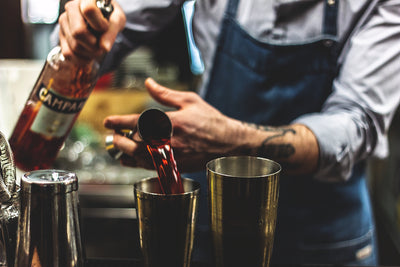
Cocktail Jigger: What is a Cocktail Jigger and how is it used?
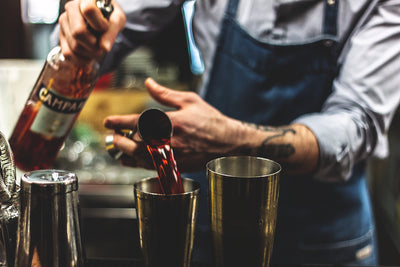
Hawthorne Strainer: What is a Hawthorne Strainer and how is it used?
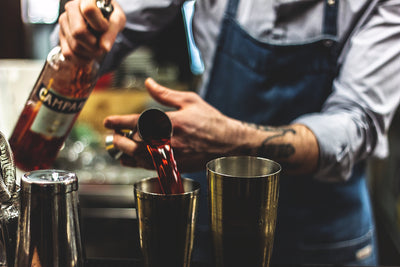
Fine Mesh Strainer: What is a Fine Mesh Strainer and how is it used?

Drip Tray: What is a Drip Tray and how are they used?
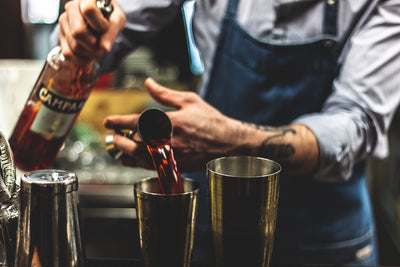
Decanter: What is a Decanter and how is it used?
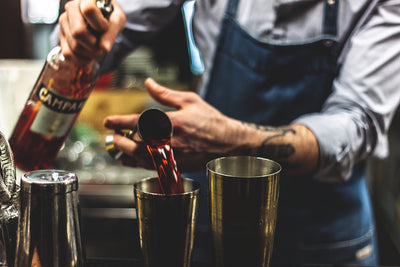
Corkscrew: What is a corkscrew and how is it used?
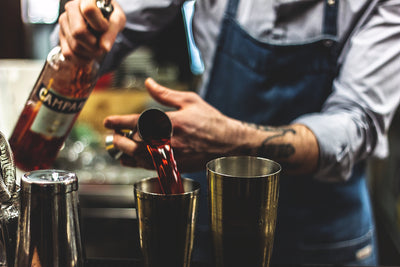
Cobbler Shaker: What is a Cobbler Shaker and How is it used?
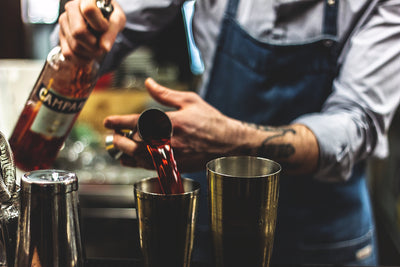
Bottle Opener: What is a Bottle Opener and how is it used?
Frequently Asked Questions About Cocktails
Making simple syrup for cocktails is an easy process that requires only two basic ingredients: sugar and water. Simple syrup is a staple in mixology because it dissolves easily into cold beverages, unlike granulated sugar. Here's how to make it:
Basic Simple Syrup Recipe
Ingredients:
- 1 cup (240 ml) water
- 1 cup (200 grams) granulated sugar
Instructions:
- Combine Sugar and Water: In a medium saucepan, combine equal parts sugar and water. The 1:1 ratio is standard for simple syrup, but you can adjust the sweetness by changing the ratio if desired. For a richer syrup (often called "rich simple syrup"), use a 2:1 ratio of sugar to water.
- Heat: Place the saucepan over medium heat. Stir the mixture gently until the sugar has completely dissolved into the water. There's no need to bring it to a boil; just heat it enough to dissolve the sugar.
- Cool: Remove the saucepan from the heat and allow the syrup to cool to room temperature.
- Store: Transfer the cooled syrup to a clean bottle or jar. Seal and store it in the refrigerator. Simple syrup can be kept refrigerated for about a month, sometimes longer if made with a higher sugar concentration.
Variations:
- Flavored Simple Syrup: You can infuse simple syrup with various flavors by adding herbs, spices, fruit zest, or other flavorings during the heating process. After the syrup has cooled, strain out the solids before storing.
- Demerara or Brown Sugar Syrup: Substitute white sugar with demerara or brown sugar for a syrup with a deeper, molasses-like flavor profile. This works well in cocktails that benefit from richer sweetness.
Simple syrup is incredibly versatile and can be used in a wide range of cocktails to add sweetness without the graininess of undissolved sugar. By making your own, you also have the option to customize the flavor and sweetness level to perfectly complement your drinks.
Cocktails are mixed drinks that typically combine spirits (alcoholic beverages like gin, vodka, whiskey, rum, tequila) with other ingredients such as fruit juice, soda, sugar, herbs, bitters, and ice to create a wide range of flavors and styles. The practice of mixing these ingredients is known as mixology. Cocktails can range from simple two-ingredient mixes to complex concoctions that require precise measurements and techniques.
The history of cocktails dates back to the 18th and 19th centuries, with the term "cocktail" first appearing in print in the early 1800s. Initially, it referred to a specific type of mixed drink, but over time, the term has come to encompass a broad category of alcoholic beverages that involve mixing various ingredients.
Cocktails are often associated with social occasions and the culture of drinking, serving not only as a form of refreshment but also as a way to experiment with flavors and presentation. The art of cocktail making has evolved significantly, with bartenders and mixologists constantly creating innovative recipes and reviving forgotten classics. The variety and creativity in cocktail preparation make them a popular choice in bars, restaurants, and homes around the world.
In addition to their recreational consumption, cocktails have become an integral part of global drinking culture, with competitions, publications, and events dedicated to the craft of cocktail making. Whether enjoyed in a sophisticated bar setting or made at home, cocktails offer a unique way to explore the vast world of spirits and flavors.
The origin of the term "cocktail" in reference to mixed drinks is subject to various theories and stories, with no definitive answer universally agreed upon. However, a few popular theories attempt to explain how the term came to be associated with alcoholic beverages:
1. Horse Tail Theory
One of the more colorful theories suggests that the term "cocktail" originated from horse trading. It was said that a ginger stick inserted into a horse's rectum would make the horse lift its tail, appearing more spirited and lively, similar to a cock's tail in appearance. This practice was called "cocktailing." The theory suggests that just as the ginger "cocktailed" the horse, alcoholic mixtures stimulated and enlivened those who drank them.
2. Cocktail Garnish Theory
Another theory posits that the name comes from the use of a cock's tail feather as a garnish in some of the early mixed drinks, serving as a decorative and identifying feature of these concoctions.
3. Coquetel Theory
There's a theory that "cocktail" is derived from the French word "coquetel," a term found in French colonial Louisiana. According to this theory, "coquetel" was a drink served at gatherings, and the term was Anglicized to "cocktail." The French term itself might have referred to a mixed drink or been related to the serving vessel.
4. Morning Drink Theory
Another suggestion is that the term originated from a mixed drink called a "cocktail" consumed in the morning, traditionally made with spirits, sugar, water, and bitters, thought to be a cure for a hangover, akin to the phrase "hair of the dog." The term might have symbolized the start of a new day, much like a rooster (cock) crows at dawn.
Historical Reference
One of the earliest documented uses of the term "cocktail" in relation to a drink appears in "The Balance and Columbian Repository" of Hudson, New York, in 1806. It was defined as a stimulating liquor, composed of spirits of any kind, sugar, water, and bitters. This definition aligns with what we now recognize as a classic cocktail.
Despite the various theories, the true origin of the term "cocktail" remains a bit of a mystery, adding to the allure and history of cocktail culture. What is clear, however, is that cocktails have evolved significantly over the years, from simple bitters-based drinks to a vast array of complex and diverse concoctions celebrated worldwide.
Simple syrup is a fundamental ingredient in cocktail making, acting as a sweetener that blends seamlessly into both cold and hot beverages. It's made from equal parts sugar and water, creating a syrup that dissolves much more easily in liquid than granulated sugar does. This characteristic makes it ideal for sweetening cocktails, where a smooth, uniform texture is desired.
Basic Simple Syrup Recipe:
- Ingredients:
- Instructions:
The ratio of sugar to water can be adjusted depending on the desired thickness and sweetness of the syrup:
- A 1:1 ratio (equal parts sugar and water) creates a standard simple syrup, which is most commonly used in cocktails.
- A 2:1 ratio (two parts sugar to one part water) makes a "rich simple syrup," which is thicker and sweeter, and you can use less of it in cocktails to achieve the same level of sweetness.
Variations and Flavors:
Simple syrup can be infused with various flavors to add complexity to cocktails. Herbs (like mint or rosemary), spices (such as cinnamon or vanilla), fruits, and even chilies can be added to the syrup while it's heating to infuse it with additional flavors. The process is the same, but the added ingredients are strained out before storing the syrup.
Uses in Cocktails:
Simple syrup is used in countless cocktails to balance acidity and add sweetness. It's a key ingredient in classics like the Mojito, Daiquiri, Whiskey Sour, and Lemon Drop, among others. Its versatility also makes it an excellent ingredient for experimenting with in your cocktail creations.
In summary, simple syrup is an indispensable tool in the mixologist's toolkit, providing an easy way to add sweetness to cocktails without the graininess of undissolved sugar, and it serves as a base for creating a wide array of flavored syrups.
For those looking to dive into the world of mixology or simply enjoy a well-crafted drink, starting with the basics is key. Here are five basic cocktails that cover a broad range of spirits and styles, each with its own history and appeal:
1. Old Fashioned
- Ingredients: Bourbon or Rye Whiskey, Sugar (or simple syrup), Angostura Bitters, Ice, Orange Peel for garnish.
- Why It’s Basic: The Old Fashioned is often considered the original cocktail, epitomizing the classic definition of a cocktail as a mixture of spirit, sugar, water, and bitters.
2. Martini
- Ingredients: Gin (or Vodka), Dry Vermouth, Ice, Olive or Lemon Twist for garnish.
- Why It’s Basic: The Martini is one of the most iconic and versatile cocktails, with variations (dry, wet, dirty) allowing for customization. It's a staple that showcases the importance of vermouth in cocktail making.
3. Margarita
- Ingredients: Tequila, Triple Sec (or Cointreau), Fresh Lime Juice, Salt for the rim (optional).
- Why It’s Basic: This cocktail is a classic example of the sour category, demonstrating the balance between the strong (tequila), the sweet (triple sec), and the sour (lime juice).
4. Negroni
- Ingredients: Gin, Campari, Sweet Vermouth, Ice, Orange Peel for garnish.
- Why It’s Basic: The Negroni is a staple aperitif with a perfect balance of bitter and sweet, introducing drinkers to the world of Italian aperitivos and the use of bitter liqueurs in cocktails.
5. Mojito
- Ingredients: White Rum, Fresh Mint Leaves, Sugar (or simple syrup), Fresh Lime Juice, Soda Water, Ice.
- Why It’s Basic: The Mojito showcases the technique of muddling to extract flavors from fresh ingredients (mint and lime) and is a prime example of a refreshing, herbaceous cocktail.
These cocktails not only serve as a solid foundation for understanding basic mixology principles but also cater to a wide range of tastes. Mastering these classics will equip you with the knowledge to explore further into the art of making drinks, experimenting with variations, and even creating your own signature cocktails.
Most bartenders, especially those trained in classic mixology, are expected to know a wide range of cocktails to cater to diverse customer preferences. While the list can be extensive, here are some of the essential cocktails that most bartenders are familiar with and can prepare:
1. Martini
- A classic cocktail made with gin (or vodka) and dry vermouth, usually garnished with an olive or a lemon twist. Variations include the Dirty Martini and the Vodka Martini.
2. Old Fashioned
- Made with bourbon or rye whiskey, sugar, Angostura bitters, and a few dashes of water or soda, garnished with an orange slice or peel and a maraschino cherry.
3. Manhattan
- A mix of whiskey (traditionally rye), sweet vermouth, and bitters, often garnished with a cherry. Variations include the Dry and Perfect Manhattan.
4. Negroni
- Comprised of equal parts gin, Campari, and sweet vermouth, typically garnished with an orange peel.
5. Margarita
- A popular cocktail made with tequila, lime juice, and triple sec or Cointreau, served with salt on the rim of the glass. Variations can include flavored Margaritas like strawberry or mango.
6. Mojito
- A refreshing drink made with white rum, sugar (traditionally sugar cane juice), lime juice, soda water, and mint.
7. Daiquiri
- A simple cocktail consisting of rum, lime juice, and sugar. While often served frozen and flavored in modern bars, the classic Daiquiri is served shaken and straight up.
8. Cosmopolitan
- A cocktail made with vodka, triple sec, cranberry juice, and freshly squeezed or sweetened lime juice, garnished with a lime slice or twist.
9. Whiskey Sour
- Prepared with whiskey (usually bourbon), lemon juice, and sugar, with an optional egg white for frothiness.
10. Sidecar
- A classic drink made with cognac, orange liqueur (such as Cointreau), and lemon juice, often served with a sugared rim.
11. Bloody Mary
- A savory cocktail consisting of vodka, tomato juice, and various spices and flavorings including Worcestershire sauce, hot sauces, garlic, herbs, horseradish, celery, olives, salt, black pepper, lemon juice, lime juice, and/or celery salt.
12. Mint Julep
- A bourbon-based cocktail mixed with sugar syrup and fresh mint, associated with the Southern United States and the Kentucky Derby.
These cocktails cover a broad spectrum of spirits and styles, from strong and neat to refreshing and fruity, ensuring bartenders can accommodate a wide range of tastes and preferences. Mastery of these classics provides a solid foundation for creating countless variations and exploring more intricate mixology.
When considering the "strongest" common cocktail, it generally refers to the alcohol content and the proportion of spirits in the mix. Cocktails that are primarily composed of spirits, with little to no non-alcoholic mixers, tend to be the strongest. One of the most potent common cocktails is the Zombie.
Zombie
The Zombie is notorious not only for its strength but also for its complexity and depth of flavor. It's a Tiki cocktail made with a potent mix of several types of rum, including light rum, dark rum, and often 151-proof rum, along with fruit juices, liqueurs, and various syrups. The exact recipe can vary, but here's a general idea:
Ingredients:
- 1 oz Light Rum
- 1 oz Dark Rum
- 1 oz Overproof Rum (often 151 proof)
- 1/2 oz Falernum (a sweet syrup)
- 1/2 oz Lime Juice
- 1 oz Pineapple Juice
- 1 oz Papaya Juice (or another tropical fruit juice)
- 1 tsp Superfine Sugar
- Dash of Angostura Bitters
- Splash of Grenadine
- Mint sprig for garnish
Instructions:
- Combine Ingredients: Except for the overproof rum, combine all ingredients with ice in a blender or shaker.
- Blend or Shake: Blend or shake until smooth.
- Pour: Pour into a tall glass filled with ice.
- Float the Overproof Rum: Carefully pour the overproof rum on top to create a float.
- Garnish: Garnish with a mint sprig or a fruit slice.
The Zombie is so strong that some bars limit customers to two Zombies due to its high alcohol content. The cocktail's creation is attributed to Donn Beach (Don the Beachcomber) in the late 1930s. He supposedly concocted it to help a hung-over customer get through a business meeting, but the customer later reported that the drink made him feel like the undead, hence the name "Zombie."
Other notably strong cocktails include the Long Island Iced Tea, which combines vodka, rum, tequila, gin, and triple sec, and the Martini, known for its high gin or vodka content relative to the small amount of vermouth.
When enjoying these strong cocktails, it's important to do so responsibly, given their high alcohol content.
The list of the most common cocktails can vary depending on trends, location, and personal preference, but certain timeless classics consistently rank among the favorites. Here are ten of the most popular and widely recognized cocktails around the world:
1. Margarita
- A refreshing mix of tequila, lime juice, and triple sec, usually served with a salted rim. It can be served shaken, on the rocks, or blended.
2. Old Fashioned
- A classic cocktail made with whiskey (bourbon or rye), sugar, bitters, and a twist of citrus rind, often garnished with a maraschino cherry.
3. Martini
- A sophisticated blend of gin and dry vermouth, garnished with an olive or a lemon twist. A Vodka Martini is a popular variation.
4. Negroni
- Composed of equal parts gin, Campari, and sweet vermouth, this cocktail is known for its perfect balance of bitterness and sweetness.
5. Mojito
- A Cuban cocktail made with white rum, sugar (traditionally sugar cane juice), lime juice, soda water, and mint.
6. Manhattan
- A mix of whiskey, sweet vermouth, and bitters, garnished with a cherry. It's a staple cocktail that showcases the depth of whiskey.
7. Daiquiri
- Traditionally made with rum, lime juice, and sugar. While often served frozen and flavored in modern times, the classic Daiquiri is shaken and served straight up.
8. Cosmopolitan
- A chic cocktail made with vodka, triple sec, cranberry juice, and freshly squeezed or sweetened lime juice, usually served in a martini glass.
9. Whiskey Sour
- A blend of whiskey, lemon juice, and sugar, with some variations including egg white for a frothy top, garnished with a slice of lemon and a cherry.
10. Pisco Sour
- Made with Pisco (a type of brandy from South America), lime juice, syrup, egg white, and bitters, creating a frothy and tangy drink.
These cocktails are beloved for their history, versatility, and the ability to please a wide range of palates. They serve as a great introduction to the world of mixology and are essential knowledge for both amateur and professional bartenders. Whether you're hosting a party, enjoying a night out, or simply exploring the art of cocktails, these ten drinks offer a solid foundation.
Batching cocktails is an efficient way to serve drinks to a large number of guests at parties, events, or in a bar setting, ensuring consistency and speed without sacrificing quality. Here’s a guide to batching cocktails effectively:
1. Choose the Right Cocktail
- Select cocktails that can be easily scaled up and don't require last-minute preparations like muddling, shaking with ice, or adding a frothy egg white.
2. Calculate Your Quantities
- Determine the total volume of cocktails you need based on your guest count. Remember, a standard cocktail serving is typically around 4 to 5 ounces (120 to 150 ml).
- Scale up the recipe accordingly. For instance, if the original recipe calls for 1 ounce of an ingredient and you're making 10 servings, you'll need 10 ounces of that ingredient.
3. Preparation
- Mix: Combine all your liquid ingredients (spirits, syrups, juices, etc.) in a large container or pitcher. If your cocktail recipe calls for water or dilution (common in stirred cocktails), add water to account for the dilution that usually occurs during shaking or stirring with ice. A general rule is to add about 20-25% of water by volume to mimic dilution.
- Chill: Since you won’t be shaking or stirring individual servings with ice (which would normally chill the drink), it’s important to refrigerate your batch ahead of time to ensure it's well-chilled.
- Bottle: For easier serving, transfer the pre-mixed cocktail into bottles. This is especially handy for outdoor events or to speed up serving at a busy bar.
4. Serving
- Have a plan for how you'll serve your batched cocktails. You can either pour them over ice in individual glasses or serve them stirred or shaken. For carbonated additions (like soda or tonic), add these just before serving to maintain fizz.
- Don’t forget garnishes! Preparing garnishes in advance and adding them to each glass can elevate the presentation of your batched cocktails.
5. Labeling
- If you’re preparing multiple batches, clearly label each container with the cocktail name and key ingredients. This is particularly helpful in a party setting where guests might be serving themselves.
Tips for Successful Batching:
- Use Fresh Ingredients: For cocktails that include fresh juices, prepare these as close to the event time as possible to maintain freshness and flavor.
- Storage: If not serving immediately, store your batched cocktail in the refrigerator to keep it chilled. Most batched cocktails can be prepared a day in advance.
- Taste Test: Before serving, always taste your batched cocktail to ensure the flavors are balanced. Adjust if necessary.
Batching cocktails is a great way to streamline service and enjoy your own event with minimal interruption. With a little planning and creativity, you can offer a sophisticated cocktail experience that your guests will love.
Craft cocktails are high-quality, artisanal drinks that emphasize creativity, precision, and the use of premium ingredients. The term "craft" reflects a dedication to the art and science of mixology, where every element of the cocktail is considered and curated for the best possible flavor, presentation, and drinking experience. Here are some defining characteristics of craft cocktails:
- Quality Ingredients: Craft cocktails are made with high-quality, often locally sourced or unique ingredients. This includes premium spirits, fresh fruits and juices, homemade syrups and bitters, and artisanal or small-batch liqueurs.
- Innovation and Creativity: Mixologists creating craft cocktails often experiment with flavors, techniques, and presentations. This can involve reimagining classic cocktails with a modern twist, incorporating unusual or exotic ingredients, or employing advanced methods such as infusion, smoking, or clarification.
- Attention to Detail: Every aspect of a craft cocktail, from the balance of flavors to the type of ice used, is carefully considered. The preparation and presentation are executed with precision, often with a focus on aesthetics as well as taste.
- Handcrafted Elements: Many craft cocktails feature handmade components, such as syrups, infusions, or bitters made in-house. These elements allow bartenders to impart unique flavors and personalize the drinking experience.
- Passion and Expertise: Craft cocktails are typically created by skilled bartenders or mixologists who are passionate about their craft. They have a deep understanding of flavor profiles, mixing techniques, and the history of cocktails, which they use to educate and engage with customers.
- Ambiance and Experience: Enjoying craft cocktails often extends beyond the drink itself to the overall experience. Many craft cocktail bars are designed with a specific theme or atmosphere in mind, offering a space where patrons can savor their drinks in a thoughtful and engaging environment.
Craft cocktails have seen a surge in popularity as more people appreciate the artistry and innovation behind these drinks. They represent a celebration of mixology, where tradition meets creativity, resulting in beverages that are not only delicious but also memorable.
Smoking cocktails is a technique used to infuse drinks with a smoky flavor, adding complexity and a dramatic presentation. There are several methods to achieve this effect, ranging from simple to more equipment-intensive. Here's how to smoke cocktails:
1. Smoking Gun Method
The smoking gun is a handheld device that burns wood chips, herbs, or spices to produce smoke, which is then directed into a cocktail.
Instructions:
- Prepare your cocktail and place it in a glass or a shaker.
- Place the wood chips in the smoking gun and light them according to the device's instructions.
- Insert the smoking gun's hose into the glass or shaker, making sure it's well-sealed.
- Turn on the smoking gun to fill the container with smoke.
- Cover the glass or shaker to trap the smoke for a few minutes, allowing the cocktail to absorb the smoky flavor.
- Uncover and serve the cocktail. For added drama, uncover in front of your guests.
2. Cloche Method
A glass cloche or a large glass bowl can be used to trap smoke around a cocktail.
Instructions:
- Prepare your cocktail in its serving glass.
- Place the cocktail on a heatproof surface.
- Use a kitchen torch to light a piece of wood, a cedar plank, or herbs on fire, then blow it out to produce smoke.
- Quickly cover the smoking item and the cocktail with the cloche or bowl to trap the smoke.
- Let it sit for a few minutes to infuse the drink with the smoky aroma.
- Lift the cloche and serve the cocktail.
3. Smoked Ice Method
Smoked ice adds a subtle smoky flavor as it melts into the drink.
Instructions:
- Smoke water using a smoker set to a low temperature until the water takes on a smoky flavor. This can take 1-2 hours.
- Freeze the smoked water in ice cube trays.
- Use the smoked ice in place of regular ice cubes in your cocktails.
4. Direct Smoking Method
Directly smoking the ingredients or the glass can impart a smoky flavor to the cocktail.
Instructions:
- Prepare your cocktail.
- For smoking a glass, invert the glass over a smoking piece of wood or herb until the inside is coated with smoke.
- For smoking ingredients, smoke them in a smoker or with a kitchen torch before adding them to the drink.
- Assemble the cocktail and serve.
Tips:
- Experiment with different types of wood chips (such as hickory, mesquite, applewood, or cherrywood) or herbs and spices to find the flavor profile you like.
- Practice safety when handling fire and smoke.
- Start with a small amount of smoke, as it can easily overwhelm the drink's other flavors.
Smoking cocktails adds an element of theatricality to the drink-making process and can transform the flavor profile of a cocktail, making it a memorable experience for both the maker and the drinker.
Using egg white in cocktails is a classic technique that adds a smooth, silky texture and a beautiful frothy cap to drinks. This method is often used in sours and fizzes to enhance the mouthfeel and appearance of the cocktail. Here’s how to safely and effectively use egg white in your cocktails:
1. Separate the Egg White
- Crack a fresh egg and separate the white from the yolk. You can do this by transferring the yolk back and forth between the two shell halves while allowing the white to fall into a bowl, or by using an egg separator.
- One large egg white is enough for one or two cocktails, depending on the recipe.
2. Dry Shake
- Add the egg white to the cocktail shaker first, without any ice. This is known as a "dry shake." Add the rest of your cocktail ingredients (except carbonated ones) to the shaker with the egg white.
- Seal the shaker tightly and shake vigorously for about 10-15 seconds. The goal here is to aerate the egg white, breaking it down to create a frothy texture.
3. Wet Shake
- After the dry shake, add ice to the shaker to chill the drink and add some dilution, which is essential for the balance of most cocktails.
- Shake again vigorously for another 10-15 seconds. This second shake chills the cocktail and helps to fully incorporate the frothy egg white into the mix.
4. Strain and Serve
- Strain the cocktail into your serving glass. Some recipes may call for a fine strain to ensure a smooth texture by removing any ice chips or larger bubbles.
- The cocktail should have a layer of frothy egg white on top, which can serve as a canvas for garnishes or decorative bitters.
5. Garnish
- A common garnish for egg white cocktails is a few drops of bitters swirled on the foam. You can also use a cocktail pick to create designs.
Safety Tips:
- Use Fresh Eggs: Always use fresh, high-quality eggs to minimize the risk of salmonella.
- Consider Pasteurized Egg Whites: For those concerned about raw egg consumption, pasteurized egg whites, available in cartons at most grocery stores, are a safe alternative that works equally well.
- Allergy Warning: Always inform your guests when using egg whites in your cocktails, as some people have egg allergies.
Popular Cocktails Featuring Egg White:
- Whiskey Sour: Whiskey, lemon juice, simple syrup, and egg white.
- Pisco Sour: Pisco, lime juice, simple syrup, egg white, and bitters.
- Clover Club: Gin, lemon juice, raspberry syrup, and egg white.
- Ramos Gin Fizz: Gin, lemon juice, lime juice, simple syrup, cream, orange flower water, egg white, and soda water.
Using egg white in cocktails might seem daunting at first, but with a bit of practice, it becomes an easy step that significantly enhances the drink's texture and visual appeal.
Yes, a cocktail is typically an alcoholic drink that combines spirits with other ingredients such as fruit juices, soda, sugar, herbs, bitters, or water. The purpose of a cocktail is to blend various flavors to create a drink that is more complex and enjoyable than the individual components on their own. Cocktails can range from simple two-ingredient recipes to elaborate concoctions with multiple components and garnishes. They are a staple of social gatherings and have a rich history in many cultures around the world. While the primary component of most cocktails is alcohol, there are also non-alcoholic versions called "mocktails" that mimic the flavor profiles of traditional cocktails using non-alcoholic ingredients.
Making raspberry syrup for cocktails is a simple process that infuses the sweet and tart flavors of raspberries into a versatile syrup. This homemade syrup can elevate your cocktails by adding depth and a beautiful color. Here's how to make it:
Raspberry Syrup Recipe
Ingredients:
- 1 cup (about 123 grams) fresh or frozen raspberries
- 1 cup (200 grams) granulated sugar
- 1 cup (240 ml) water
Instructions:
- Combine Ingredients: In a saucepan over medium heat, combine the raspberries, sugar, and water. Stir gently to mix.
- Simmer: Bring the mixture to a simmer, stirring occasionally to dissolve the sugar. Once the sugar is dissolved, continue to simmer for about 10-15 minutes. The raspberries will break down and the liquid should take on a deep red color.
- Strain: Remove the saucepan from the heat. Set a fine-mesh sieve over a bowl and pour the raspberry mixture through it to strain out the solids. Use a spoon to press down on the raspberries to extract as much liquid as possible. For an even clearer syrup, you can strain it a second time through a cheesecloth or a coffee filter.
- Cool: Allow the syrup to cool to room temperature. Then, transfer it to a clean bottle or jar and seal tightly.
- Refrigerate: Store the raspberry syrup in the refrigerator. It should keep for up to two weeks.
Tips:
- Adjusting Sweetness: You can adjust the sweetness of the syrup by increasing or decreasing the amount of sugar. Start with the recipe as is and then modify it according to your taste in future batches.
- Adding Flavor: For an extra layer of flavor, consider adding a strip of lemon or orange peel, a sprig of fresh mint, or a piece of ginger to the saucepan while simmering. Just remember to remove any added aromatics when straining the syrup.
- Using Frozen Raspberries: If fresh raspberries aren't available, frozen raspberries work just as well. There's no need to thaw them before use.
Homemade raspberry syrup is a fantastic addition to a wide range of cocktails, lending them a vibrant color and a delightful berry flavor. Try it in a raspberry mojito, a raspberry lemonade spritzer, or use it to sweeten and flavor your favorite gin or vodka cocktails.
For beginners, either in making or tasting cocktails, it's best to start with classic cocktails that feature straightforward recipes and common ingredients. These cocktails not only provide a solid foundation for understanding basic mixology principles but also offer a delicious introduction to the world of cocktails. Here are a few recommendations:
1. Gin & Tonic
- Ingredients: Gin, tonic water, and lime or lemon wedge for garnish.
- Why It's Great for Beginners: The Gin & Tonic is simple, refreshing, and requires no special equipment. It's a perfect example of how two ingredients can create a classic drink.
2. Whiskey Sour
- Ingredients: Whiskey, fresh lemon juice, simple syrup, and optional egg white for frothiness.
- Why It's Great for Beginners: It introduces the technique of shaking and the concept of balancing sour and sweet flavors in a cocktail.
3. Mojito
- Ingredients: White rum, fresh lime juice, mint leaves, sugar (or simple syrup), soda water.
- Why It's Great for Beginners: Making a Mojito involves muddling, which is a key mixology skill. It's also a great way to understand how herbs can be used in cocktails.
4. Negroni
- Ingredients: Gin, Campari, and sweet vermouth.
- Why It's Great for Beginners: With its equal parts ratio, the Negroni is an easy cocktail to remember and make. It introduces beginners to the concept of aperitifs and the balance of bitter and sweet flavors.
5. Margarita
- Ingredients: Tequila, triple sec (or Cointreau), and fresh lime juice, with salt for rimming the glass.
- Why It's Great for Beginners: The Margarita showcases the importance of fresh citrus in cocktails and teaches the technique of rimming a glass. It's also a fundamental sour cocktail that's beloved worldwide.
6. Old Fashioned
- Ingredients: Bourbon or rye whiskey, sugar (or simple syrup), Angostura bitters, and orange twist for garnish.
- Why It's Great for Beginners: This cocktail is a lesson in simplicity and elegance, teaching beginners how to stir a cocktail properly and the role bitters play in cocktail making.
When starting out, it's important to use quality ingredients and measure them accurately to achieve the best taste. Experimenting with these classic cocktails can also lead to a better understanding of personal flavor preferences and the basics of cocktail customization. Enjoy the process of learning and tasting!
A signature cocktail is a distinctive drink created to represent a specific bar, restaurant, event, or individual. These cocktails are often designed to reflect the unique style, theme, or preferences of the entity they represent, offering a special and memorable experience for guests. Signature cocktails can serve various purposes, such as:
- Brand Identity for Venues: Bars and restaurants may create signature cocktails to highlight their mixology expertise, showcase unique ingredients, or align with their overall aesthetic and culinary approach. These drinks can become a draw for customers seeking a unique drinking experience.
- Personal Touch for Events: For weddings, parties, or corporate events, a signature cocktail can add a personalized touch that reflects the hosts' personalities, the event theme, or a specific message they want to convey to their guests. It's a creative way to make the occasion more memorable.
- Signature of a Mixologist or Bartender: Individual bartenders or mixologists may develop signature cocktails as a way to express their creativity and skills. These drinks can become associated with the creator, showcasing their ability to innovate and craft unique flavor combinations.
- Marketing and Promotion: A well-crafted signature cocktail can serve as a marketing tool, encouraging word-of-mouth promotion and social media sharing. It can also be used to highlight partnerships with specific spirit brands or to showcase seasonal or locally sourced ingredients.
Creating a signature cocktail involves careful consideration of flavors, presentation, and the story or concept behind the drink. It often requires experimentation to achieve a balance that appeals to the target audience while standing out for its originality and appeal. Whether it's for a venue, an event, or an individual, a signature cocktail is a statement of identity and creativity in the world of mixology.
Use this text to answer questions in as much detail as possible for your customers.
The invention of cocktails is a topic with a rich and somewhat murky history, as mixed drinks of various forms have been around for centuries. However, the term "cocktail" in the context we understand today—a mixture of spirits with other ingredients like water, sugar, and bitters—is generally traced back to the late 18th to early 19th century.
One of the earliest documented uses of the word "cocktail" dates to an editorial response in "The Balance and Columbian Repository," a publication from Hudson, New York, on May 13, 1806. The editor defined a cocktail as a stimulating liquor, composed of spirits of any kind, sugar, water, and bitters. This is what we now refer to as an Old Fashioned cocktail.
The exact origins of why mixed drinks started being called "cocktails" and how they evolved into a sophisticated art form are subject to various legends and stories. Some theories suggest the term "cocktail" may have originated from the practice of garnishing the drinks with a feather from a cock's tail, while others propose that it derived from a mispronunciation of the French term for egg cup, "coquetel," which was used for serving spirits in New Orleans.
Cocktail culture truly began to flourish during the 19th century, particularly in the United States and England, where the industrial revolution and the rise of commercial distillation techniques made spirits more widely available. The golden age of cocktails is often considered to be the late 19th to the early 20th century, a period that saw the creation of many classic cocktails still enjoyed today.
Prohibition in the United States (1920-1933) had a significant impact on cocktail culture, driving it underground and fostering the growth of speakeasies, where the art of cocktail making continued to evolve in secrecy. After Prohibition was repealed, cocktails regained their popularity, and the culture continued to grow, leading to the diverse and creative world of mixology we know today.
In recent decades, there has been a renaissance in cocktail culture, with a strong emphasis on craft cocktails, quality ingredients, and innovative techniques, reflecting a deep appreciation for the history and artistry of cocktail making.
Cocktails can often be more expensive than other types of drinks for several reasons, all of which contribute to the cost of crafting a high-quality cocktail. Here are some of the primary factors that influence the price:
1. Quality of Ingredients
- Cocktails usually involve multiple ingredients, including premium spirits, fresh juices, house-made syrups, and exotic bitters. Higher quality ingredients cost more, and the diversity of ingredients needed for a single cocktail can add up.
2. Labor and Expertise
- Crafting cocktails requires skilled bartenders who not only have a thorough understanding of mixology but also the ability to consistently create complex drinks. The training and expertise of these professionals are factored into the cost.
3. Preparation Time
- Unlike pouring a beer or wine, making a cocktail involves a more time-consuming process that can include muddling, shaking, stirring, straining, and garnishing. This preparation time reduces the number of drinks a bartender can make in a given period, contributing to the higher price.
4. Equipment and Presentation
- Specialized equipment (shakers, strainers, muddlers, etc.) and high-quality glassware also contribute to the overall cost. Additionally, the presentation of cocktails often involves garnishes and decorative elements, adding to the expense.
5. Wastage
- Fresh ingredients like fruits, herbs, and some syrups have a limited shelf life, leading to wastage. The cost associated with ingredients that spoil or are not used is often factored into the price of cocktails.
6. Venue Overheads
- The ambiance, location, and other overhead costs of the venue (rent, utilities, licenses) are higher for establishments specializing in high-quality cocktails, and these costs are reflected in drink prices.
7. Profit Margins
- Beverages, including cocktails, are a significant source of profit for bars and restaurants. The pricing often reflects not just the cost of making the drink but also the establishment's need to maintain a healthy profit margin.
8. Experience and Craft
- Part of what you pay for with a cocktail is the experience of enjoying a drink that's been carefully crafted and balanced by someone with the skills to do so. For many, the experience of trying unique cocktails in a nice setting is worth the extra cost.
In summary, while cocktails can be expensive, the price is reflective of the quality of ingredients, the skill and time required to make them, and the overall experience offered by the venue. For enthusiasts who appreciate the art of cocktails, these factors justify the higher prices.
Clarifying cocktails is a technique used to remove solids and create a crystal-clear beverage while maintaining the drink's flavors. It's a method often used in modern mixology to add a touch of elegance and surprise to cocktails. There are several methods to clarify cocktails, but one of the most popular and accessible techniques is using agar agar or the milk punch method. Here's how to do it:
Milk Punch Clarification Method:
This method involves using milk to curdle the cocktail and then straining out the curds, leaving behind a clear liquid.
Ingredients:
- Your cocktail of choice, pre-mixed
- Whole milk (the amount may vary, but a general guideline is to use about 1/4 to 1/3 the volume of your cocktail)
- Citrus juice (if your cocktail doesn't already contain it, as it's necessary to curdle the milk)
Steps:
- Mix Your Cocktail: Prepare your cocktail as usual, ensuring it contains some form of acidity, typically from citrus juice. The acid is crucial as it will curdle the milk in the next steps.
- Add Milk: In a separate container, gently warm the milk until it's just lukewarm. Do not boil. Then, combine your cocktail with the warm milk. The milk will curdle almost immediately upon contact with the acidic cocktail.
- Rest: Allow the mixture to rest at room temperature for a few hours or refrigerate overnight. This resting period gives the milk curds time to form and capture the cloudiness and particulates from the cocktail.
- Strain: Line a fine-mesh sieve with a cheesecloth or a coffee filter and place it over another container. Slowly pour the curdled mixture through the lined sieve. The curds will catch most of the solids, and the clear liquid will drip through. This step might need to be repeated several times with a clean filter to achieve the desired clarity.
- Fine Strain: For an extra-clear cocktail, pass the liquid through a fine filter, such as a coffee filter or a paper towel, one more time.
- Serve: Chill the clarified cocktail before serving. You can bottle it for later use or serve it immediately over ice, garnished as desired.
Agar Agar Clarification Method:
This method uses agar agar, a vegetarian gelatin substitute, to create a gel that traps the solids in the cocktail, which are then filtered out.
Steps:
- Hydrate Agar Agar: Dissolve agar agar in a small amount of hot water (follow package instructions for the correct ratio).
- Mix with Cocktail: Once the agar agar solution has cooled but not set, mix it with your pre-made cocktail.
- Set: Allow the mixture to cool and set into a gel. This can be done in the refrigerator to speed up the process.
- Break and Strain: Once set, break up the gel into small pieces and strain through a cheesecloth or coffee filter. The gel will trap the solids, and the clear cocktail will be filtered out.
Both methods can produce stunningly clear cocktails while preserving the original flavors of the drink. The choice of method can depend on the specific cocktail, the ingredients on hand, and personal preference.
Sour mix, also known as sweet and sour mix, is a versatile cocktail ingredient that provides both the sweet and sour components needed in many cocktails, especially in sour family drinks. It's a blend of sugar syrup and citrus juice, typically lemon and/or lime. Here's how to make a basic homemade sour mix:
Homemade Sour Mix Recipe
Ingredients:
- 1 cup water
- 1 cup sugar
- 1 cup freshly squeezed lemon juice
- 1 cup freshly squeezed lime juice
You can adjust the ratio of lemon to lime based on your taste preferences or the specific requirements of the cocktails you plan to make.
Instructions:
- Make Simple Syrup: Combine the water and sugar in a saucepan over medium heat. Stir until the sugar is completely dissolved into the water. Allow the simple syrup to cool to room temperature. This process creates a sweet base for your sour mix.
- Mix Citrus Juices: While the simple syrup is cooling, juice enough lemons and limes to make one cup of each. It's important to use fresh citrus to get the best flavor for your sour mix.
- Combine: Once the simple syrup has cooled, mix it with the freshly squeezed lemon and lime juices. Stir well to ensure everything is thoroughly combined.
- Bottle and Store: Transfer the sour mix to a clean bottle or jar with a lid. Store it in the refrigerator. When stored properly, homemade sour mix can last for up to two weeks.
Tips for Making Sour Mix:
- Strain the Citrus Juice: To ensure your sour mix is smooth, strain the lemon and lime juices through a fine mesh strainer to remove any seeds or pulp before combining with the simple syrup.
- Adjust to Taste: If you prefer your sour mix to be sweeter or more sour, you can adjust the ratios of sugar and citrus juice to suit your taste. Some prefer a 2:1 ratio of citrus juice to simple syrup for a tarter mix.
- Add Flavors: Consider infusing your simple syrup with herbs (like mint or basil), spices (such as cinnamon or cloves), or even cucumber for an additional layer of flavor in your sour mix.
Homemade sour mix is far superior in taste to most store-bought versions and can be used in a variety of cocktails like Whiskey Sours, Margaritas, and Long Island Iced Teas. Making your own also allows you to control the quality of ingredients and the balance of flavors, elevating your cocktail experience.
Creating foam for cocktails adds a luxurious texture and visual appeal, enhancing the overall drinking experience. There are several methods to achieve a stable, flavorful foam, but one of the most popular and accessible techniques is using egg whites or aquafaba (for a vegan alternative). Another method involves using a whipped cream dispenser charged with N2O cartridges. Here's how to make foam for cocktails using these methods:
Egg White/Aquafaba Foam:
Ingredients:
- Egg white from one large egg or 1 oz (30 ml) aquafaba (chickpea brine)
- Optional: Flavors such as citrus juice, syrups, or bitters
Instructions:
- Combine Ingredients: In a shaker, combine the egg white or aquafaba with the rest of your cocktail ingredients. If you're adding flavors to the foam alone, shake the egg white or aquafaba with these flavoring agents first.
- Dry Shake: Perform a dry shake (shaking without ice) vigorously for about 10-15 seconds. This step is crucial for aerating the egg white or aquafaba, starting the emulsification process that creates the foam.
- Wet Shake: Add ice to the shaker and shake again vigorously. This step chills the cocktail and continues to build the foam.
- Strain and Serve: Strain the cocktail into your serving glass. You'll notice a layer of foam forming on top. Let the cocktail sit for a moment to allow the foam to fully separate and rise to the top.
Whipped Cream Dispenser Method:
Ingredients:
- 2-3 egg whites or 3 oz (90 ml) aquafaba
- Optional: Flavors such as citrus juice, syrups, or bitters
- 1 N2O cream charger
Instructions:
- Prepare the Mixture: Combine the egg whites or aquafaba with your chosen flavors in the canister of a whipped cream dispenser. Ensure the mixture is well combined.
- Charge: Screw on the lid of the dispenser tightly and insert an N2O charger into the charger holder. Twist the charger holder onto the valve of the dispenser until the gas is released into the canister.
- Shake: Shake the dispenser vigorously for several seconds to ensure the gas is fully incorporated into the egg white or aquafaba mixture.
- Dispense: Invert the dispenser and gently squeeze the lever to dispense the foam on top of your cocktail. The N2O creates a stable, airy foam that holds its shape well.
Both methods can produce beautiful, flavorful foam that adds a professional touch to cocktails. The egg white or aquafaba method is straightforward and doesn't require special equipment beyond a shaker, while the whipped cream dispenser method offers convenience and consistency, especially when making foam for multiple drinks.
The concept of "core cocktails" can vary depending on the source, but many cocktail enthusiasts and bartenders agree on a set of classic cocktails that serve as the foundation for understanding the art of mixology. These core cocktails showcase a range of spirits, techniques, and flavor profiles. While there isn't a universally accepted list of exactly five, the following cocktails are often cited as essential classics that every bartender should know, and they offer a solid introduction to the world of cocktails:
- Old Fashioned: A testament to the simplicity and elegance of classic cocktails, the Old Fashioned is made with bourbon or rye whiskey, sugar, bitters, and a twist of citrus peel. It's a benchmark for understanding balance and the importance of high-quality ingredients.
- Martini: The Martini is a quintessential cocktail that epitomizes refinement and versatility. Traditionally made with gin and dry vermouth and garnished with an olive or a lemon twist, the Martini can be adjusted (dry, wet, dirty) to suit any taste. Variations include the Vodka Martini.
- Manhattan: A classic cocktail that combines whiskey (traditionally rye), sweet vermouth, and bitters. The Manhattan showcases the smooth interplay between the warmth of the whiskey and the sweetness of the vermouth, garnished typically with a cherry.
- Negroni: Known for its beautiful balance of bitter and sweet, the Negroni is made with equal parts gin, Campari, and sweet vermouth. It's celebrated for its complexity and has inspired countless variations.
- Daiquiri: Far removed from its frozen, fruity counterparts often found at beach resorts, the classic Daiquiri is a simple yet sophisticated cocktail made with rum, lime juice, and sugar. It highlights the importance of proportion and the ability to balance tartness with sweetness.
These five core cocktails not only represent a range of spirits and flavors but also teach fundamental mixology skills, such as stirring, shaking, balancing flavors, and presenting drinks. Mastering these classics provides a solid foundation for exploring more intricate and innovative cocktails.
Starting with cocktails, whether as a budding mixologist or someone who simply enjoys a good drink, can be both exciting and a bit overwhelming given the vast array of recipes and techniques available. Here's a streamlined approach to get you started on your cocktail journey:
1. Learn Basic Techniques
Understanding a few fundamental techniques can significantly improve the quality of your cocktails:
- Shaking: Combines ingredients quickly and adds aeration, ideal for cocktails with citrus or egg whites.
- Stirring: For a clearer and smoother cocktail, usually for spirit-forward drinks.
- Muddling: Extracts flavors and oils from fresh ingredients like herbs and fruits.
- Straining: Removes ice and solid ingredients from the final drink.
- Layering: Creates visually appealing layers by carefully pouring ingredients of different densities.
2. Gather Essential Tools
Start with some basic bar tools:
- Cocktail shaker
- Mixing glass
- Bar spoon
- Muddler
- Jigger (for measuring)
- Strainer
3. Stock Your Home Bar
You don’t need every spirit under the sun to start. Begin with a few basics:
- Spirits: Vodka, gin, rum, tequila, and whiskey.
- Liqueurs: Triple sec (or Cointreau), vermouth (sweet and dry).
- Mixers: Soda, tonic water, cola.
- Fresh Ingredients: Lemons, limes, simple syrup, and maybe some bitters.
4. Start with Classic Cocktails
Familiarize yourself with a few classic recipes. These drinks cover basic techniques and are a good foundation for understanding cocktail composition:
- Martini (Gin or Vodka)
- Margarita (Tequila)
- Old Fashioned (Whiskey)
- Mojito (Rum)
- Negroni (Gin)
5. Practice and Experiment
Practice making these classics to get comfortable with the techniques. Then, feel free to experiment by swapping out spirits, adjusting ratios, or adding new flavors.
6. Taste as You Go
Developing a good palate is crucial. Taste your cocktails as you make them to understand how flavors combine and balance.
7. Explore and Learn
The world of cocktails is vast and full of history. Reading books, watching tutorials, and following cocktail blogs or social media accounts can provide inspiration and deepen your knowledge.
8. Enjoy Responsibly
Part of the cocktail experience is enjoying your creations with friends and family, but always remember to drink responsibly.
Starting with cocktails is about building a foundation of knowledge and skills and then exploring to find what you love. Cheers to your cocktail journey!
Creating the perfect cocktail is an art that combines creativity, balance, precision, and a touch of personal flair. Whether you're making a classic drink or inventing something new, here are some steps and tips to help you craft the perfect cocktail:
1. Understand the Basics
- Familiarize yourself with classic cocktails and their components. Knowing the foundations of mixology, such as the balance between sweet, sour, bitter, and strong elements, will help you create well-balanced drinks.
2. Use Quality Ingredients
- Start with high-quality spirits as they form the base of your cocktail. Freshly squeezed juices, homemade syrups, and fresh herbs can significantly improve the taste of your drink.
3. Master the Ratios
- Most classic cocktails follow simple ratios (e.g., 2:1:1 for a Margarita—two parts spirit, one part lime juice, one part triple sec). Understanding these ratios can help you balance your cocktails and serve as a guideline for creating your variations.
4. Measure Accurately
- Use a jigger or a measuring cup to ensure precise measurements. Consistency is key to replicating the perfect cocktail every time.
5. Consider the Ice
- The type and quality of ice can impact a cocktail's temperature and dilution. For stirred drinks, large ice cubes that melt slowly are ideal. For shaken cocktails, smaller ice cubes or crushed ice will chill the drink quickly.
6. Shake or Stir
- Knowing when to shake and when to stir is crucial. As a general rule, cocktails containing only spirits (like a Martini) should be stirred to maintain clarity and smoothness. Cocktails with juice, cream, or eggs (like a Whiskey Sour) should be shaken to ensure proper mixing and aeration.
7. Taste as You Go
- Before serving, taste your cocktail by dipping a straw into the drink and covering one end with your finger to sample a small amount. Adjust the ingredients as necessary to achieve the desired balance.
8. Pay Attention to Presentation
- The appearance of a cocktail is your first impression. Use an appropriate glass for the type of cocktail you're serving. Garnishes should complement the drink both visually and in flavor.
9. Keep Experimenting
- The perfect cocktail is often subjective and tailored to individual tastes. Don't be afraid to experiment with different ingredients, proportions, and techniques.
10. Serve with Confidence
- A great cocktail is not just about the drink itself but the experience of enjoying it. Serve your cocktail with confidence and a smile.
Remember, the journey to making the perfect cocktail is a continuous learning experience filled with experimentation and discovery. Keep practicing, and don't be afraid to tweak recipes to suit your preferences or those of your guests.
Aquafaba is a vegan alternative to egg whites used in cocktails to create the same frothy, creamy texture that egg whites provide. The term "aquafaba" literally means "bean water" and refers to the viscous liquid left over from cooking legumes, such as chickpeas. This liquid has properties similar to egg whites, making it an excellent substitute for creating foam or meringue in both culinary and mixology contexts.
In cocktails, aquafaba is used to achieve the silky mouthfeel and frothy top layer that egg whites traditionally contribute to drinks like the Whiskey Sour, Pisco Sour, or any sour category cocktail that calls for egg whites. It's especially popular among vegans or those with egg allergies but has also been embraced by bartenders looking for plant-based alternatives to traditional ingredients.
Using Aquafaba in Cocktails:
- Proportion: Typically, about 1 ounce (30 ml) of aquafaba is used to replace the egg white in a cocktail recipe.
- Preparation: Aquafaba doesn't need special preparation for cocktail use. It can be used straight from the can of unsalted chickpeas or from cooking liquid if you're boiling your chickpeas.
- Mixing: To incorporate aquafaba into cocktails, it's usually added to the other ingredients and then shaken vigorously without ice (dry shake) to aerate and foam up. After the dry shake, ice is added for a second shake (wet shake) to chill the drink.
- Taste and Texture: Aquafaba is neutral in flavor, so it won't alter the taste profile of the cocktail. Its primary function is to add a creamy texture and frothy head to the drink, similar to egg whites.
The use of aquafaba in cocktails is a testament to the creativity and adaptability of modern mixology, allowing bartenders to cater to a broader range of dietary preferences without compromising on the quality or presentation of their drinks.
In the context of making cocktails, "muddle" refers to the process of pressing ingredients against the bottom of a glass or cocktail shaker with a muddler. A muddler is a bartender's tool, typically made of wood, stainless steel, or plastic, that is used to crush and mix ingredients. The purpose of muddling is to release the flavors, oils, and juices of the ingredients, such as fruits, herbs, or spices, into the cocktail.
Muddling is a gentle action; it's not about pulverizing the ingredients but rather about carefully extracting the flavors. For example, when muddling mint for a Mojito or basil for a Basil Smash, the goal is to press the leaves enough to release their essential oils without tearing them excessively, which can lead to bitterness from the chlorophyll in the leaves. Similarly, when muddling fruit, the objective is to break down the fruit to release its juice and flavor while avoiding crushing any seeds, which might impart unwanted bitterness.
Proper muddling technique can significantly enhance the flavor profile of a cocktail, adding depth and complexity that simply mixing the ingredients would not achieve. It's a fundamental technique in mixology, especially important in the creation of certain classic cocktails and modern concoctions alike.
Sour mix, also known as sweet and sour mix, is a popular cocktail ingredient used to impart both sweetness and tartness to a variety of mixed drinks, particularly in those classified as "sours." It's a versatile, pre-made syrup that combines the flavors of lemon and/or lime juice with a sweetener, typically simple syrup or sugar.
Basic Sour Mix Recipe:
Ingredients:
- 1 cup (240 ml) water
- 1 cup (200 grams) sugar (to make simple syrup)
- 1 cup (240 ml) fresh lemon juice
- 1 cup (240 ml) fresh lime juice
Instructions:
- Make Simple Syrup: Dissolve the sugar in water over medium heat, stirring until the sugar is completely dissolved, then allow it to cool. This creates your simple syrup.
- Combine: Mix the simple syrup with equal parts of freshly squeezed lemon and lime juice. Stir until well combined.
- Store: Transfer the sour mix to a clean bottle or jar and store it in the refrigerator. It should keep for up to two weeks.
Tips for Using Sour Mix:
- Always prefer fresh lemon and lime juice over store-bought versions for the best taste and natural acidity.
- Adjust the ratio of lemon to lime juice based on your preference or specific cocktail requirements.
- You can customize your sour mix by adding other citrus juices (like orange or grapefruit) or infusing it with herbs and spices for additional complexity.
Sour mix is a convenient way to add a consistent sweet-tart flavor to cocktails without the need to measure out and balance individual sweeteners and citrus juices for each drink. It's commonly used in cocktails like Whiskey Sours, Margaritas, and Long Island Iced Teas, among others. While commercially prepared sour mixes are available, making your own allows for better control over the quality and flavor balance, enhancing the overall taste of your cocktails.
Making clear ice for cocktails not only enhances their aesthetic appeal but also improves their quality by melting slower and diluting the drink less rapidly. The cloudiness in regular ice is caused by impurities and air bubbles trapped during the freezing process. To achieve clear ice, you need a method that allows water to freeze slowly and directionally, mimicking the natural freezing process of lakes and rivers where ice forms clear from the bottom up. Here's a simple method to make clear ice at home:
Directional Freezing Method
You'll Need:
- Distilled water (optional, can help but is not necessary)
- An insulated cooler small enough to fit in your freezer
- A serrated knife or ice saw
- An ice pick or mallet
Instructions:
- Prep the Cooler: Remove the lid from the cooler to ensure that the freezing process happens only from the top down. If your cooler is too large for your freezer, you might need to find a smaller cooler or adjust your freezer shelves.
- Fill the Cooler: Fill the cooler with water. Using distilled water can help achieve even clearer ice, but tap water can also produce good results. Leave about an inch of space at the top to allow the water to expand as it freezes.
- Freeze: Place the cooler in the freezer. The insulation slows down the freezing process, allowing it to start from the top and push impurities and air bubbles to the bottom. Freeze for about 24 to 48 hours, depending on your freezer's temperature and the cooler's size. You're aiming for a large block of ice that's frozen on top with a small amount of unfrozen water underneath.
- Unmold: Remove the cooler from the freezer and let it sit at room temperature for a few minutes to loosen the ice block. If necessary, use warm water on the outside of the cooler to help release the ice.
- Separate Clear Ice: Once you've removed the ice block, you'll notice the top part is clear, and the bottom has cloudy impurities. Use a serrated knife or ice saw to carefully cut off the clear portion.
- Cut Into Cubes: Use the serrated knife to score lines where you want to cut, then gently tap along these lines with an ice pick or the back of the knife to split the ice into cubes or desired shapes.
- Store: Keep your clear ice cubes in a sealed bag or container in the freezer to prevent them from absorbing odors.
This method requires a bit of patience and practice, especially when cutting the ice into your desired shapes. However, the result is impressively clear ice that elevates the presentation of your cocktails significantly. Clear ice not only looks professional but also melts slower due to its density, making your drinks colder and less diluted.
Vodka is a versatile spirit that serves as the base for many popular cocktails due to its neutral flavor, making it an excellent canvas for a wide array of mixers and ingredients. Here are some well-known vodka-based cocktails:
1. Martini
- Traditionally made with gin, the vodka martini swaps gin for vodka and is mixed with dry vermouth, often garnished with an olive or a lemon twist.
2. Moscow Mule
- A refreshing cocktail made with vodka, spicy ginger beer, and lime juice, typically served in a copper mug.
3. Bloody Mary
- A savory cocktail that combines vodka with tomato juice, lemon juice, Worcestershire sauce, hot sauces, and various spices, garnished with celery, pickles, or even prawns.
4. Cosmopolitan
- A chic and tart cocktail made with vodka, triple sec (or Cointreau), cranberry juice, and lime juice, served in a martini glass and garnished with a lime wheel or orange zest.
5. Screwdriver
- A simple yet popular drink made by mixing vodka with orange juice, often served over ice in a highball glass.
6. White Russian
- A creamy cocktail consisting of vodka, coffee liqueur (like Kahlúa), and heavy cream or milk, served over ice.
7. Vodka Tonic
- A straightforward, refreshing drink made with vodka and tonic water, often garnished with a lime wedge.
8. Black Russian
- Made with vodka and coffee liqueur, served over ice. It becomes a White Russian with the addition of cream.
9. Caipiroska
- A variation of the Caipirinha, replacing cachaça with vodka, mixed with lime and sugar.
10. Sea Breeze
- A light, fruity cocktail that combines vodka with cranberry juice and grapefruit juice, served over ice and garnished with a lime wedge.
These cocktails showcase vodka's ability to blend seamlessly with various flavors, from the simplicity of a Screwdriver to the complex layers of a Bloody Mary. Whether you're a fan of sweet, sour, or savory drinks, there's likely a vodka cocktail that suits your taste.
Shrubs, also known as drinking vinegars, are a combination of fruit, sugar, and vinegar. They're used in cocktails to add depth, complexity, and a refreshing acidity. Making your own shrubs at home is a simple process that allows for creativity in choosing flavors. Here's a basic guide to making shrubs for cocktails:
Basic Shrub Recipe
Ingredients:
- 1 cup fruit (fresh or frozen, finely chopped or mashed)
- 1 cup granulated sugar
- 1 cup vinegar (apple cider vinegar is popular, but you can also use white wine vinegar, red wine vinegar, or balsamic vinegar for different flavors)
Instructions:
- Combine Fruit and Sugar: In a bowl, mix the fruit with the sugar. Cover and let it sit at room temperature. The sugar will draw out the liquid from the fruit, creating a syrup. This process can take from a few hours to a day, depending on the fruit's juiciness and your preference for how infused you want the syrup to be.
- Strain: After the fruit has macerated in the sugar and created a syrup, strain the mixture to remove the fruit solids. You can use a fine mesh strainer or cheesecloth. Press or squeeze the fruit to extract as much syrup as possible.
- Add Vinegar: To the strained syrup, add the vinegar. Stir well until the sugar is completely dissolved in the vinegar. The ratio can be adjusted based on how sweet or tart you like your shrub.
- Bottle and Store: Transfer the shrub to a clean bottle or jar. Seal and store it in the refrigerator. Letting it sit for a few days to a week will allow the flavors to meld and mellow. Shrubs can last for several months refrigerated.
Tips for Making Shrubs:
- Experiment with Flavors: Feel free to experiment with different types of fruits, sugars (such as cane sugar, brown sugar, or honey), and vinegars to create unique flavor combinations.
- Herbs and Spices: For added complexity, consider adding herbs (like mint, basil, or rosemary) or spices (like peppercorns, cloves, or cinnamon) during the maceration process.
- Serving: To use in cocktails, mix a small amount of shrub (starting with about 1/2 ounce) with your choice of spirits and other mixers. Adjust according to taste. Shrubs can also be mixed with soda water for a non-alcoholic refreshment.
Shrubs offer a tangy, sweet, and fruity component to cocktails, adding an extra layer of flavor that can elevate the drink experience. They are also a great way to preserve seasonal fruits and experiment with flavor pairings in your mixology creations.
Sweet vermouth, with its aromatic and slightly sweet profile, is a key ingredient in many classic and contemporary cocktails. It adds depth, complexity, and a hint of herbal sweetness to drinks. Here are several notable cocktails that use sweet vermouth:
1. Manhattan
- A sophisticated blend of whiskey (traditionally rye, but bourbon is also common), sweet vermouth, and a dash of Angostura bitters, usually garnished with a cherry. It's a staple of classic cocktail menus.
2. Negroni
- An iconic Italian cocktail made with equal parts gin, Campari, and sweet vermouth. It's known for its perfect balance of bitterness and sweetness, garnished with an orange peel.
3. Boulevardier
- Similar to a Negroni but substitutes the gin with bourbon, offering a warmer, whiskey-forward profile balanced by the Campari and sweet vermouth.
4. Rob Roy
- Essentially a Scotch whisky Manhattan, this cocktail combines Scotch, sweet vermouth, and Angostura bitters, typically garnished with a maraschino cherry.
5. Americano
- A lighter aperitif made with Campari, sweet vermouth, and a splash of soda water, garnished with an orange slice. It's refreshing and has a pleasant bitterness.
6. Martinez
- A precursor to the modern Martini, the Martinez mixes gin (often Old Tom Gin for sweetness), sweet vermouth, maraschino liqueur, and Angostura bitters, creating a rich and complex drink.
7. Torino-Milano
- A simple, yet flavorful, cocktail made with equal parts Campari and sweet vermouth, served over ice and garnished with an orange slice. It’s a lesser-known but delightful aperitif.
8. Vieux Carré
- A New Orleans classic, the Vieux Carré blends rye whiskey, Cognac, sweet vermouth, Bénédictine, with dashes of Peychaud’s and Angostura bitters, served on the rocks.
These cocktails showcase the versatility of sweet vermouth, demonstrating its ability to complement a wide range of spirits and flavors. Whether used as a primary ingredient or a supporting player, sweet vermouth is essential to the art of cocktail making, offering a bridge between bitter and sweet elements in a drink.
Making cocktails at home can be a fun and rewarding experience, allowing you to explore creative flavor combinations and hone your mixology skills. Here’s a basic guide to get you started on making delicious cocktails at home:
1. Gather Your Tools
- Cocktail Shaker: Essential for mixing and chilling cocktails that include juices, syrups, cream, or egg whites.
- Mixing Glass: Used for stirred cocktails, typically those made entirely with spirits.
- Bar Spoon: Long spoon for stirring cocktails.
- Jigger: Measuring tool to accurately measure liquid ingredients.
- Strainer: To strain out ice and other solid ingredients from the cocktail.
- Muddler: For mashing fruits, herbs, or spices to release their flavors.
2. Stock Your Bar
- Spirits: Start with basics like vodka, gin, rum, tequila, whiskey, and perhaps one or two liqueurs like triple sec or vermouth.
- Mixers: Include both non-alcoholic (soda, tonic water, ginger beer) and sweeteners (simple syrup, agave nectar).
- Fresh Citrus: Lemons and limes are essential for many classic cocktails.
- Bitters: A few dashes can add depth to your drinks.
3. Learn Basic Techniques
- Shaking: Combines ingredients vigorously, cooling and diluting the drink. Ideal for cocktails with citrus or egg whites.
- Stirring: Gently mixes drinks to achieve clarity and a silky texture, perfect for spirit-forward cocktails.
- Muddling: Releases the essential oils and flavors from fresh ingredients like herbs and fruit.
4. Start with Classic Recipes
Begin with classic cocktails to familiarize yourself with basic ratios and methods. Some easy ones include:
- Martini (Gin or Vodka and Dry Vermouth)
- Margarita (Tequila, Lime Juice, and Triple Sec)
- Old Fashioned (Whiskey, Sugar, and Bitters)
- Mojito (Rum, Mint, Lime, Sugar, and Soda Water)
5. Experiment and Adjust
- Don’t be afraid to tweak recipes according to your taste preferences. Adjust the sweetness, sourness, or alcohol content to suit your palate.
6. Presentation Matters
- Choose the right glass for your cocktail (highball, lowball, martini glass, etc.).
- Add garnishes to enhance both the look and flavor of your drinks. Common garnishes include citrus twists, fresh herbs, and fruit slices.
7. Enjoy Responsibly
- Remember to enjoy your creations responsibly and consider the preferences of your guests if you’re hosting.
Example Recipe: Classic Whiskey Sour
Ingredients:
- 2 oz Whiskey
- ¾ oz Fresh Lemon Juice
- ½ oz Simple Syrup
- Ice
- Egg white (optional for frothiness)
- Cherry or lemon twist for garnish
Instructions:
- Combine whiskey, lemon juice, simple syrup, and egg white (if using) in a shaker.
- Dry shake (without ice) vigorously if using egg white.
- Add ice to the shaker and shake again until well-chilled.
- Strain into a rocks glass filled with ice.
- Garnish with a cherry or lemon twist.
Making cocktails at home allows for endless creativity and personalization. With some basic equipment, a few key ingredients, and a bit of practice, you can craft bar-quality cocktails in the comfort of your own home.
Listing the 50 most popular cocktails in the world can vary based on the year, trends, regional preferences, and time. However, most of the cocktails on the cocktail.co list are classics that have stood the test of time or gained international fame for their classic appeal and widespread popularity. Here's a list that encompasses a broad range of these beloved drinks, offering something for every taste:
- Margarita - Tequila, lime juice, triple sec
- Old Fashioned - Bourbon or rye whiskey, sugar, bitters
- Negroni - Gin, Campari, sweet vermouth
- Martini - Gin or vodka, dry vermouth
- Mojito - White rum, sugar, lime juice, soda water, mint
- Manhattan - Whiskey, sweet vermouth, bitters
- Daiquiri - Rum, lime juice, sugar
- Whiskey Sour - Whiskey, lemon juice, sugar
- Cosmopolitan - Vodka, triple sec, cranberry juice, lime juice
- Espresso Martini - Vodka, coffee liqueur, espresso
- Pisco Sour - Pisco, lime juice, simple syrup, egg white
- Sazerac - Rye whiskey or cognac, absinthe, sugar, bitters
- French 75 - Gin, lemon juice, sugar, Champagne
- Bloody Mary - Vodka, tomato juice, lemon juice, spices
- Gin Fizz - Gin, lemon juice, sugar, soda water
- Mai Tai - Rum, lime juice, orgeat syrup, orange liqueur
- Moscow Mule - Vodka, spicy ginger beer, lime juice
- Mint Julep - Bourbon, mint, sugar, water
- Caipirinha - Cachaça, sugar, lime
- Sidecar - Cognac, orange liqueur, lemon juice
- Tom Collins - Gin, lemon juice, sugar, soda water
- Aperol Spritz - Prosecco, Aperol, soda water
- Dark 'n' Stormy - Dark rum, ginger beer
- Amaretto Sour - Amaretto, lemon juice, sugar, egg white (optional)
- Paloma - Tequila, grapefruit soda, lime juice
- Long Island Iced Tea - Vodka, tequila, rum, gin, triple sec, lemon juice, cola
- Penicillin - Scotch whisky, lemon juice, honey-ginger syrup
- Bramble - Gin, lemon juice, simple syrup, crème de mûre
- Aviation - Gin, maraschino liqueur, crème de violette, lemon juice
- Last Word - Gin, green Chartreuse, maraschino liqueur, lime juice
- Rum Punch - Rum, orange juice, pineapple juice, grenadine
- Singapore Sling - Gin, cherry heering, lemon juice, soda water
- Clover Club - Gin, lemon juice, raspberry syrup, egg white
- Corpse Reviver #2 - Gin, Lillet Blanc, orange liqueur, lemon juice, absinthe
- Vesper Martini - Gin, vodka, Lillet Blanc
- Hurricane - Rum, passion fruit juice, orange juice, lime juice
- Tequila Sunrise - Tequila, orange juice, grenadine
- Piña Colada - Rum, coconut cream, pineapple juice
- Gimlet - Gin or vodka, lime juice, simple syrup
- White Russian - Vodka, coffee liqueur, cream
- Black Russian - Vodka, coffee liqueur
- John Collins - Bourbon, lemon juice, sugar, soda water
- Paper Plane - Bourbon, Aperol, Amaro Nonino, lemon juice
- Zombie - Rum, apricot brandy, lime juice, pineapple juice
- Bee's Knees - Gin, lemon juice, honey syrup
- Gold Rush - Bourbon, lemon juice, honey syrup
- El Diablo - Tequila, crème de cassis, lime juice, ginger beer
- Jungle Bird - Dark rum, Campari, lime juice, pineapple juice
- Southside - Gin, lime juice, simple syrup, mint
- Fernet con Coca - Fernet-Branca, cola

